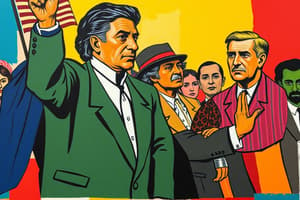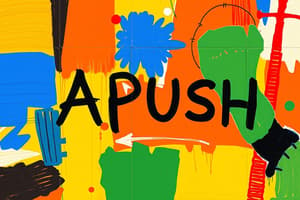Podcast
Questions and Answers
Which cities had a population greater than 1 million by 1890?
Which cities had a population greater than 1 million by 1890?
- Philadelphia (correct)
- Chicago (correct)
- New York (correct)
- Los Angeles
Who contributed to the development of the skyscraper?
Who contributed to the development of the skyscraper?
Louis Sullivan
What extended city limits outward?
What extended city limits outward?
Electric trolleys
Many were drawn to cities because they had amenities such as __________.
Many were drawn to cities because they had amenities such as __________.
What was a major problem in cities due to trash?
What was a major problem in cities due to trash?
Where did new immigrants predominantly come from?
Where did new immigrants predominantly come from?
Many Americans feared that new immigrants would assimilate easily into their new land.
Many Americans feared that new immigrants would assimilate easily into their new land.
Why did immigrants come to America?
Why did immigrants come to America?
What portrayed the U.S. as the land of great opportunity?
What portrayed the U.S. as the land of great opportunity?
What did many immigrants struggle with after moving to the U.S.?
What did many immigrants struggle with after moving to the U.S.?
What did the federal government do concerning immigrant assimilation?
What did the federal government do concerning immigrant assimilation?
What type of jobs did powerful bosses trade for votes?
What type of jobs did powerful bosses trade for votes?
Who established Hull House?
Who established Hull House?
What was the Anti-Foreigner organization created in 1887 called?
What was the Anti-Foreigner organization created in 1887 called?
The Chinese Exclusion Act barred all immigrants from entering the U.S.
The Chinese Exclusion Act barred all immigrants from entering the U.S.
What was the 18th Amendment?
What was the 18th Amendment?
Who invented the phonograph?
Who invented the phonograph?
What emerged in the 1880's to meet the demand for fun?
What emerged in the 1880's to meet the demand for fun?
What sport became the national pastime in 1870?
What sport became the national pastime in 1870?
Who wrote Looking Backward?
Who wrote Looking Backward?
What did women start to do in response to urban life?
What did women start to do in response to urban life?
Flashcards are hidden until you start studying
Study Notes
Urban Growth and Development
- By 1890, New York, Chicago, and Philadelphia each had populations exceeding 1 million.
- Urban architecture was revolutionized by Louis Sullivan, who played a pivotal role in developing skyscrapers.
- Electric trolleys expanded city boundaries, facilitating urban sprawl and access to city amenities.
Urban Amenities and Challenges
- Cities attracted residents due to offerings like electricity, indoor plumbing, and telephones.
- Trash disposal became a significant issue, with waste from everyday items like bottles, bags, and cans accumulating.
Immigration Trends
- "New Immigrants" arrived primarily from southern and eastern Europe, where democratic traditions and living conditions were often scarce.
- Many native-born Americans feared that these immigrants would not assimilate, leading to a divisive view of society as either a "melting pot" or a "dumping ground."
- The European population surge, which doubled after 1800, prompted mass migration to America as land shortages became acute.
Perceptions of America
- The notion of "America Fever" spread among Europeans, who viewed the United States as a land of opportunity.
Immigrant Experiences
- A considerable number of immigrants intended to return to their homelands after earning money, while those who stayed grappled with cultural preservation amidst challenges.
- The federal government remained passive regarding immigrant assimilation into American society.
Political Dynamics in Urban Areas
- "Boss" systems emerged, where political bosses exchanged jobs for votes, assisting immigrants with employment and community services.
- Organized labor often opposed immigrants, viewing them as strike-breakers and a threat to labor movements.
Nativism and Restrictive Legislation
- Nativist sentiments flourished, as the original Anglo-Saxon population feared being outnumbered and blamed immigrants for economic woes.
- The American Protective Association was founded in 1887 as an anti-foreigner organization explicitly targeting Roman Catholic candidates.
- The first restrictive immigration law passed in 1882, targeting paupers, criminals, and convicts.
Religious Shifts and Reforms
- Traditional Protestant churches struggled to remain relevant amidst urbanization, leading to a rise in urban revivalism to fill the moral void.
- Dwight Lyman Moody emerged as a key figure in adapting Christianity to urban issues, founding the Moody Bible Institute to extend his outreach.
Social Services and Women's Activism
- Jane Addams founded Hull House to provide services like English instruction, childcare, and cultural activities for immigrants.
- Settlement houses became hubs of social reform and women's activism.
- Florence Kelley and others paved the way for women in social work to advocate for marginalized communities.
Educational Advancements
- Public education gained traction, with tax-supported elementary and high schools becoming more common after the Civil War.
- Booker T. Washington became a prominent advocate for black education, establishing the Tuskegee Institute to promote vocational training.
Cultural and Literary Development
- Increased literacy coincided with a rise in book reading and publishing, introducing works by authors like Mark Twain and Kate Chopin who explored core American themes.
- The emergence of dime novels and authors like Horatio Alger reflected the growing popularity of storytelling and fictional narratives set against American backdrops.
Social Movements and Changes
- The National American Woman Suffrage Association was founded in 1890, though it largely excluded black women, reflecting racial divisions within the suffrage movement.
- The rise of feminism was highlighted by figures like Charlotte Perkins Gilman, who urged women to pursue independence and economic contribution.
Prohibition and Social Change
- Alcohol consumption surged during the Civil War, leading to the formation of organizations dedicated to temperance, culminating in the 18th Amendment which established national prohibition in 1919.
Recreational and Spectator Sports
- The late 19th century saw the emergence of several spectator sports, with baseball being recognized as the national pastime and the establishment of professional leagues.
- Football exemplified the growing trend towards organized spectator sports, while basketball was invented in 1891 by James Naismith to enhance physical education.
Studying That Suits You
Use AI to generate personalized quizzes and flashcards to suit your learning preferences.




